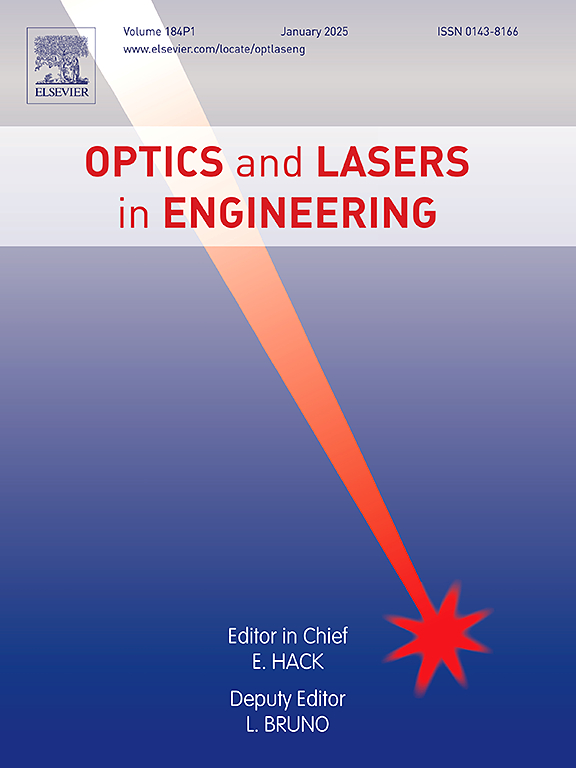基于边缘滤波的MG-Y激光器高频参数表征
IF 3.7
2区 工程技术
Q2 OPTICS
引用次数: 0
摘要
调制光栅y支(MG-Y)可调谐激光器的参数表征是确保稳定和精确的波长输出的必要条件。为了满足高频激光调谐过程中对高采样率的要求,本文提出了一种适合MG-Y激光器的基于边缘滤波的表征方法。该方法采用可调谐光纤滤波器(TFF)对激光输出进行边缘滤波。滤波后的光功率由光电二极管(PD)检测并转换为电压信号,使采样率显著高于光谱仪或波长计等传统仪器。利用激光的低频调谐路径,采用粒子群优化算法(PSO)迭代确定指定波长目标的最优控制参数集。这使得在高频调谐条件下对MG-Y激光器进行表征,并支持生成电流-波长查找表(LUT)。实验结果表明,所构建的LUT在40 nm调谐范围内包含2001个波长点,在200.71 kHz调谐频率下,波长精度为±5.8 pm,标准差为2.8 pm,满足后续光纤布拉格光栅(FBG)解调应用的性能要求。本文章由计算机程序翻译,如有差异,请以英文原文为准。
Edge-filtering-based high-frequency parameter characterization for MG-Y lasers
The parameter characterization of Modulated Grating Y-branch (MG-Y) tunable lasers is essential for ensuring stable and precise wavelength output. To meet the high sampling rate demands during high-frequency laser tuning, this paper proposes an edge-filtering-based characterization method tailored for MG-Y lasers. The method employs a Tunable Fiber Filter(TFF) to perform edge filtering on the laser output. The filtered optical power is detected by a Photo-Diode(PD) and converted into a voltage signal, enabling a sampling rate significantly higher than that of conventional instruments such as spectrometers or wavelength meters. Utilizing the laser’s low-frequency tuning path, a Particle Swarm Optimization (PSO) algorithm is applied to iteratively determine the optimal control parameter sets for designated wavelength targets. This enables the characterization of MG-Y lasers under high-frequency tuning conditions and supports the generation of a current-to-wavelength Look-Up Table (LUT). Experimental results demonstrate that the constructed LUT contains 2001 wavelength points over a 40 nm tuning range, achieving a wavelength accuracy of ±5.8 pm with a standard deviation of 2.8 pm at a tuning frequency of 200.71 kHz, thereby meeting the performance requirements for subsequent Fiber Bragg Grating (FBG) demodulation applications.
求助全文
通过发布文献求助,成功后即可免费获取论文全文。
去求助
来源期刊

Optics and Lasers in Engineering
工程技术-光学
CiteScore
8.90
自引率
8.70%
发文量
384
审稿时长
42 days
期刊介绍:
Optics and Lasers in Engineering aims at providing an international forum for the interchange of information on the development of optical techniques and laser technology in engineering. Emphasis is placed on contributions targeted at the practical use of methods and devices, the development and enhancement of solutions and new theoretical concepts for experimental methods.
Optics and Lasers in Engineering reflects the main areas in which optical methods are being used and developed for an engineering environment. Manuscripts should offer clear evidence of novelty and significance. Papers focusing on parameter optimization or computational issues are not suitable. Similarly, papers focussed on an application rather than the optical method fall outside the journal''s scope. The scope of the journal is defined to include the following:
-Optical Metrology-
Optical Methods for 3D visualization and virtual engineering-
Optical Techniques for Microsystems-
Imaging, Microscopy and Adaptive Optics-
Computational Imaging-
Laser methods in manufacturing-
Integrated optical and photonic sensors-
Optics and Photonics in Life Science-
Hyperspectral and spectroscopic methods-
Infrared and Terahertz techniques
 求助内容:
求助内容: 应助结果提醒方式:
应助结果提醒方式:


